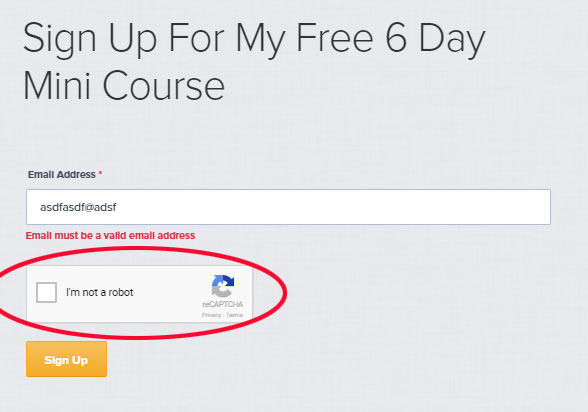What if I told you that you are currently overpaying your email marketing provider by up to 30%?
What if I also told you that hundreds or even thousands of email addresses in your database are spam emails?
Unfortunately, it’s a reality.
There are thousands of spammers out there who spend their days going from site to site and signing up for email lists with bogus addresses.
Now I have no idea why spammers do this. After all, there’s no real benefit that I can think of for corrupting someone’s email list. But the problem has been getting worse from year to year.
For example when I first discovered this problem back in 2015, I found that almost 25% of my daily email subs were completely bogus!
So what did I do?
I immediately switched all of my email forms to double optin thinking that it would solve the problem.
But guess what? Double optin didn’t help at all!
These new robot spammers actually click on the links in your emails to fool most double optin protocols.
They also click on links in your broadcasts to make it seem as though they are active subs when they have no sales value whatsoever.
Here’s an example of a robot that I found on my email list the other day.
This particular bot subscribed multiple times within 4 hours and clicked on every link in every email that I sent. Scary right?
Most attacks are dual pronged. One bot is programmed to sign up for your list and the other is programmed to open and click on every single email it receives.
Now if you are looking at your stats from a high level, this email sub looks like an incredibly engaged follower. Their open rate is 100% and so is their click through rate!
But in reality, it’s just a robot that is wasting your money and here’s the kicker…
Even if you clean out your email list regularly, you will never eliminate these bots because they look like quality subs.
And over time, you will be paying for an army of bogus emails that will never buy your products.
Get My Free Mini Course On How To Start A Successful Ecommerce Store
If you are interested in starting an ecommerce business, I put together a comprehensive package of resources that will help you launch your own online store from complete scratch. Be sure to grab it before you leave!
How Many Spam Email Bots Do You Have?
Unfortunately, it’s really difficult to locate bots in your existing email list unless you have an email provider that allows you to easily track email activity.
In fact, bot spam is one of the big reasons why I switched to Drip as my main email provider.
Now this is beyond the scope of today’s post, but Drip allows you to assign a point score to every single person that subscribes to your list.
For example, if someone clicks on a link in your email, they are awarded 3 points. An email open is worth 1 point. If someone has visited your blog multiple times in a week, they are awarded points as well.
Anyway by collating and isolating subscribers that have ridiculously high point values within a short period of time, you can easily tell who is a bot and who is not.
Editor’s Note: There are many other reasons why I switched to Drip but that is a topic for another day.
In the example above, this particular bot amassed a point score of 239 within 4 hours. There’s absolutely no way a human would do this.
By setting rules in Drip to detect unusually high score values, I can easily mark these subs as bots to be removed from my list.
For example, I have a rule in place where if the lead score exceeds 100 points within a day, that sub is marked as a spam bot.
Look For Funky Email Addresses
Most bots also use funky email addresses with strange numbers.
For example, I was looking through my list and found the following bogus email addresses.
- larry12394.chip.cheapcalgarypainting.com
- lespd178902345.store.levelopes.com
- ouster1902384.prism.bestwrinklecreamnow.com
In my experience, any email address with more than one dot (ie. store.levelsopes.com) is most likely a bot. In addition, any email address that contains a bunch of numbers is usually bogus as well.
I’ve also found that every email address with a .ru suffix is 99% likely to be spam as well. The same goes with .cz and .pl. (Yes…you are reading that correctly. I’m filtering out entire countries)
If you see any of these in your current list, then I’d take a closer look at their activity. If it looks suspicious, then just delete.
In Drip, I have rules in place to look for these email patterns and eliminate bogus subs immediately.
How To Eliminate 99% Of Email Bot Spam
Unfortunately, finding bogus email addresses within an already contaminated email list is extremely difficult but there are a few simple things you can implement to eliminate bot spam going forward.
Here’s how most spam bots work…
- Email spam bot lands on a site and parses the HTML
- Email spam bot looks for an HTML form with “email address” as a field
- Email spam bot fills out form with a bogus email address
- Email spam bot clicks on all links in every email sent which defeats double optin
But here’s the kicker… (Warning: Technical terminology ahead:))
Most of these bots are programmed to only read HTML but can’t handle cookies or javascript.
What does this mean?
As long as you don’t use straight HTML for your email forms, you can avoid 99% of email bot spam.
For example here’s how I solved my email spam problem. Instead of using an html form on my site like the following…
<form action=”#” method=”post”>
<input type=”email” name=”fields[email]” value=”” />
<input type=”submit” name=”submit” value=”I’m Ready!” />
</form>
I decided to place the form HTML in a file and load it using javascript
<div id=”dripourstory”></div>
<script>
jQuery(“#dripourstory”).load(“myform”);
</script>
Because most bots can’t parse javascript, they will not see any forms on your site. Only humans using fully featured web browsers will be able to use your forms.
Handling More Sophisticated Bots
While the javascript code example above will probably eliminate most of your email bot spam, there are more sophisticated bots out there.
If the problem is severe enough, you may want to consider going the captcha route. A captcha is a challenge or test that a person must pass to prove that he or she is human.
Here’s an example of a captcha form in case you don’t know what I’m talking about.
Now there are many advances that Google has made recently that make captchas less intrusive but it’s not perfect. And some captchas are extremely difficult to solve even if you are a real human.
For example, here’s a captcha that I got the other day on a blog when I tried to enter in my email address.
Note: This site was using Google’s latest invisible captcha technology which as it turns out is not always invisible:)
I ended up failing this captcha human test the first time and then said “screw it, I’m not signing up”.
As a result, I don’t recommend using a captcha unless the spam problem is extremely severe.
Another thing you can try is setting a cookie and not allowing the email sub to be transmitted unless the cookie is present on the browser.
Similar to the javascript method outlined above, most bots are designed to be as lean as possible and can’t handle cookies.
Either way, there are several solutions that you can choose from that should work for you.
Action Items
If this is the first time that you’ve heard of email bot signup spam, then you should go through your email list right now.
Even if you have a tens of thousands of email subs, it pays to do a few spot checks to see if there any traces of spam in your list.
- Do you see really funky email addresses that look computer generated?
- Do you see an abundance or .ru addresses or emails outside of your target country?
- Do you see unusual click or open activity?
If so, you have a spam problem which is costing you money.
And if you are using HTML forms on your site, you might want to consider switching over to something slightly more obfuscated that email spam bots can’t easily parse.
Good luck!
photo credit: Instrument and Bucket robots Robot

Ready To Get Serious About Starting An Online Business?
If you are really considering starting your own online business, then you have to check out my free mini course on How To Create A Niche Online Store In 5 Easy Steps.
In this 6 day mini course, I reveal the steps that my wife and I took to earn 100 thousand dollars in the span of just a year. Best of all, it's free and you'll receive weekly ecommerce tips and strategies!
Related Posts In Email Marketing
- Email Blast Best Practices And The Right Way To Segment Your List
- How To Grow Your Email List By 56% Overnight With Group Giveaways
- Mailchimp Alternatives – 6 Competitors That Are Cheaper & Better
- The Abandoned Cart Email Sequence That Recovers 19% Of My Sales (Without A Coupon)
- Mailchimp Pricing – The Best And Cheapest Plan For Your Money

Steve Chou is a highly recognized influencer in the ecommerce space and has taught thousands of students how to effectively sell physical products online over at ProfitableOnlineStore.com.
His blog, MyWifeQuitHerJob.com, has been featured in Forbes, Inc, The New York Times, Entrepreneur and MSNBC.
He's also a contributing author for BigCommerce, Klaviyo, ManyChat, Printful, Privy, CXL, Ecommerce Fuel, GlockApps, Privy, Social Media Examiner, Web Designer Depot, Sumo and other leading business publications.
In addition, he runs a popular ecommerce podcast, My Wife Quit Her Job, which is a top 25 marketing show on all of Apple Podcasts.
To stay up to date with all of the latest ecommerce trends, Steve runs a 7 figure ecommerce store, BumblebeeLinens.com, with his wife and puts on an annual ecommerce conference called The Sellers Summit.
Steve carries both a bachelors and a masters degree in electrical engineering from Stanford University. Despite majoring in electrical engineering, he spent a good portion of his graduate education studying entrepreneurship and the mechanics of running small businesses.


















HI
STEVE C
Awesome! Post. Thanks for shearing your secrets about ” Many Bots Do You Have”. I am really searching last few hours for such type of info and finally i got. once again thanks.